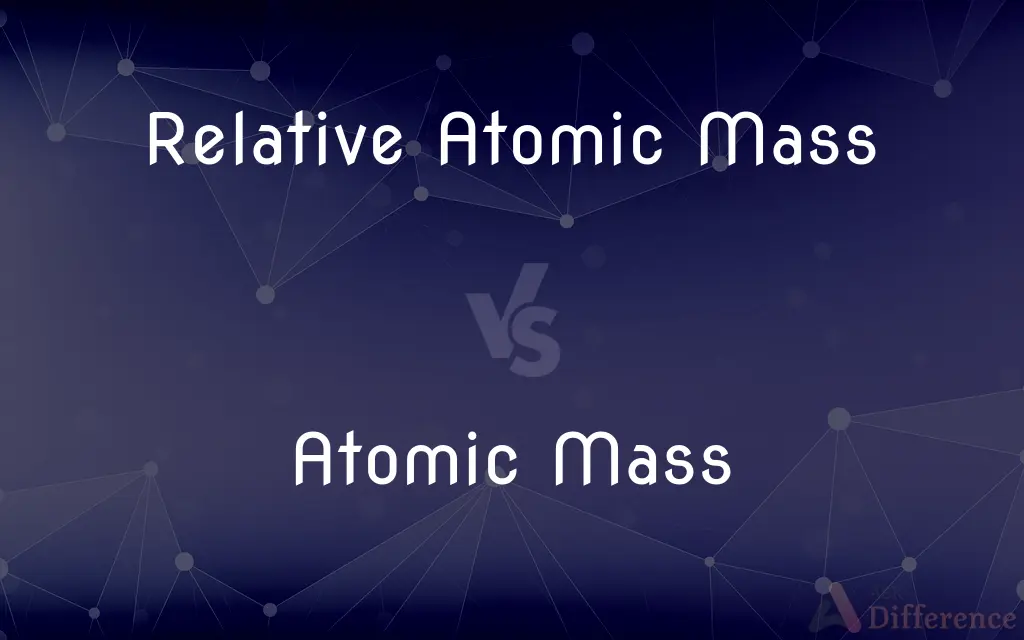Relative Atomic Mass vs. Atomic Mass — What's the Difference?
By Tayyaba Rehman — Published on October 31, 2023
Relative Atomic Mass is the average mass of an atom compared to one-twelfth of carbon-12's mass, while Atomic Mass refers to the mass of a specific isotope.

Difference Between Relative Atomic Mass and Atomic Mass
Table of Contents
ADVERTISEMENT
Key Differences
When discussing elements, the term Relative Atomic Mass often surfaces, representing the weighted average mass of an atom, normalized against one-twelfth the mass of carbon-12. In contrast, Atomic Mass is more specific, pinpointing the exact mass of an individual isotope of an element.
In their utilization, Relative Atomic Mass accounts for the various isotopes of an element and their natural abundance. Atomic Mass, however, remains undistracted by the broader picture, focusing solely on the mass of a singular isotope.
The periodic table predominantly displays the Relative Atomic Mass for elements. This value provides a general understanding, given that elements naturally occur as a mixture of isotopes. On the other side, Atomic Mass would be detailed in more specialized literature or studies, especially those scrutinizing specific isotopes.
It's crucial to differentiate between these terms in scientific contexts. Relative Atomic Mass gives a generalized viewpoint, essential for basic chemistry and broad applications. In contrast, Atomic Mass supplies precise details, invaluable for nuanced scientific work involving particular isotopes.
Moreover, while Relative Atomic Mass tends to remain almost constant for an element across sources (barring minute variations due to source differences), Atomic Mass can vary significantly between isotopes of the same element.
ADVERTISEMENT
Comparison Chart
Definition
Weighted average mass of atoms relative to carbon-12.
Exact mass of a specific isotope.
Reference Point
One-twelfth the mass of carbon-12.
No specific reference; intrinsic value.
Periodic Table
Displayed value for elements.
Not typically displayed.
Variation
Almost constant for an element across sources.
Can vary between isotopes of the same element.
Usage
General chemistry and broad applications.
Specialized studies focusing on specific isotopes.
Compare with Definitions
Relative Atomic Mass
Reflects the natural isotope abundance of an element.
Due to isotopic differences, the Relative Atomic Mass of chlorine is about 35.5.
Atomic Mass
An intrinsic property of a particular atomic nucleus.
Helium's Atomic Mass is close to 4 due to its two protons and two neutrons.
Relative Atomic Mass
A normalized value for easy comparison across elements.
Relative Atomic Mass ensures standardized measurements in chemical equations.
Atomic Mass
Reflects the number of protons and neutrons in the nucleus.
The Atomic Mass gives insight into an atom's nuclear composition.
Relative Atomic Mass
A dimensionless quantity essential for basic chemistry.
Relative Atomic Mass helps in determining molecular weights of compounds.
Atomic Mass
Not influenced by isotope abundance.
Despite its rarity, each isotope has its distinct Atomic Mass.
Relative Atomic Mass
An atom's mass compared to carbon-12.
Chemists use Relative Atomic Mass to compare elements without using exact masses.
Atomic Mass
Precise value essential for in-depth isotopic studies.
Nuclear physicists often reference the exact Atomic Mass in their research.
Relative Atomic Mass
The average atomic mass of an element's isotopes.
The Relative Atomic Mass of hydrogen is approximately 1.008.
Atomic Mass
The specific mass of an isotope.
Tritium's Atomic Mass is approximately 3.
Common Curiosities
Why does the periodic table display Relative Atomic Mass and not Atomic Mass?
The Relative Atomic Mass provides a generalized value, accounting for natural isotope abundance, whereas Atomic Mass is specific to one isotope.
How is Atomic Mass defined?
Atomic Mass refers to the mass of a specific isotope of an element.
Why is carbon-12 used as a reference in Relative Atomic Mass?
Carbon-12 provides a consistent standard, and its Relative Atomic Mass is defined as exactly 12.
Do all elements have multiple isotopes?
Most elements have multiple isotopes, but some, like fluorine, have only one stable isotope, influencing its Relative Atomic Mass and Atomic Mass.
Can I find Atomic Mass on the periodic table?
Typically, periodic tables show Relative Atomic Mass. To find a specific Atomic Mass, one might need specialized references.
What is Relative Atomic Mass?
Relative Atomic Mass is the weighted average mass of an atom compared to one-twelfth of carbon-12's mass.
Can Atomic Mass change for an element?
Yes, Atomic Mass can differ between isotopes of the same element.
Is Atomic Mass a rounded value?
No, Atomic Mass is an exact value specific to an isotope, while Relative Atomic Mass is typically a rounded average.
Are Relative Atomic Mass values always whole numbers?
No, Relative Atomic Mass values are often not whole numbers due to the influence of various isotopes and their abundances.
Why is Relative Atomic Mass a dimensionless quantity?
Relative Atomic Mass is a ratio, comparing an element's atomic mass to a fraction of carbon-12's mass, making it dimensionless.
How do isotopes impact Relative Atomic Mass?
The Relative Atomic Mass considers the mass and abundance of all naturally occurring isotopes of an element.
Is Atomic Mass the sum of protons and neutrons?
While Atomic Mass closely reflects the sum of protons and neutrons, it also considers the binding energy in the nucleus.
Do Relative Atomic Mass and Atomic Mass have units?
Relative Atomic Mass is dimensionless and has no units. Atomic Mass, when not used as a relative value, can be expressed in atomic mass units (amu) or similar units.
How is the Relative Atomic Mass of an element with only one stable isotope determined?
For elements with only one stable isotope, the Relative Atomic Mass and Atomic Mass are nearly the same.
Which value, Relative Atomic Mass or Atomic Mass, is more useful in nuclear physics?
In nuclear physics, the precise Atomic Mass is often more relevant than the averaged Relative Atomic Mass.
Share Your Discovery

Previous Comparison
Smartphone vs. Touch Phone
Next Comparison
Toaster Oven vs. Electric OvenAuthor Spotlight
Written by
Tayyaba RehmanTayyaba Rehman is a distinguished writer, currently serving as a primary contributor to askdifference.com. As a researcher in semantics and etymology, Tayyaba's passion for the complexity of languages and their distinctions has found a perfect home on the platform. Tayyaba delves into the intricacies of language, distinguishing between commonly confused words and phrases, thereby providing clarity for readers worldwide.
















































